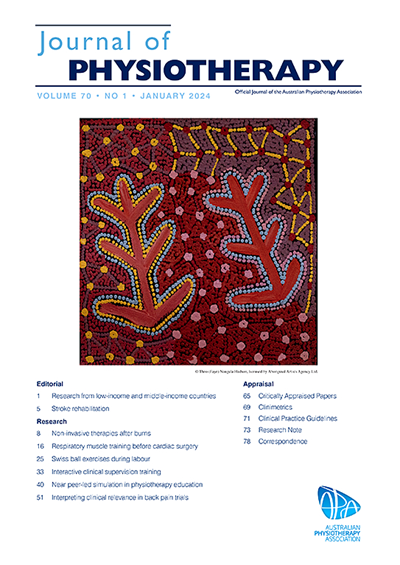临床医生在初级保健中为腰痛患者提供安慰的经验:一项定性研究。
IF 9.7
1区 医学
Q1 ORTHOPEDICS
引用次数: 0
摘要
问题:物理治疗师和脊椎指压治疗师对非特异性腰痛患者提供了什么保证?它是如何交付的?为非特异性腰痛患者提供安慰的障碍和推动因素是什么?设计:定性研究。参与者:32名肌肉骨骼临床医生(16名物理治疗师和16名脊椎指压治疗师),他们在初级保健中治疗腰痛。方法:采用半结构式访谈法,对患者的安心体验进行调查。访谈日程是使用理论领域框架制定的,并使用框架主题分析进行分析。结果:确定了四个主题:给予保证是提供高质量护理的核心临床技能;自信地传递安慰需要练习和经验;尽管感觉自己有能力和动力,临床医生还是发现了一些挑战提供安慰的情况;保证需要根据个人的情况而定。结论:临床医生对安慰有很强的理解,但需要临床经验来自信地提供安慰。这项研究为临床实践中如何个性化保证提供了见解,包括为临床医生提供关于如何有效地为腰痛患者实施保证的建议。本文章由计算机程序翻译,如有差异,请以英文原文为准。
Clinician experiences in providing reassurance for patients with low back pain in primary care: a qualitative study
Questions
What reassurance is being delivered by physiotherapists and chiropractors to people with non-specific low back pain? How is it being delivered? What are the barriers and enablers to delivering reassurance to people with non-specific low back pain?
Design
A qualitative study.
Participants
Thirty-two musculoskeletal clinicians (16 physiotherapists and 16 chiropractors) who manage low back pain in primary care.
Method
Semi-structured interviews were conducted about their experiences delivering reassurance. The interview schedule was developed using the Theoretical Domains Framework and analysed using framework thematic analysis.
Results
Four themes were identified: giving reassurance is a core clinical skill for delivering high-quality care; it takes practice and experience to confidently deliver reassurance; despite feeling capable and motivated, clinicians identified situations that challenge the delivery of reassurance; and reassurance needs to be contextualised to the individual.
Conclusion
Clinicians possess a strong understanding of reassurance but require clinical experience to confidently deliver it. This study provides insights into how reassurance is individualised in clinical practice, including suggestions for clinicians about how to implement reassurance effectively for people with low back pain.
求助全文
通过发布文献求助,成功后即可免费获取论文全文。
去求助
来源期刊

Journal of Physiotherapy
ORTHOPEDICS-REHABILITATION
CiteScore
11.40
自引率
7.40%
发文量
69
审稿时长
72 days
期刊介绍:
The Journal of Physiotherapy is the official journal of the Australian Physiotherapy Association. It aims to publish high-quality research with a significant impact on global physiotherapy practice. The journal's vision is to lead the field in supporting clinicians to access, understand, and implement research evidence that will enhance person-centred care. In January 2008, the Journal of Physiotherapy became the first physiotherapy journal to adhere to the ICMJE requirement of registering randomized trials with a recognized Trial Registry. The journal prioritizes systematic reviews, clinical trials, economic analyses, experimental studies, qualitative studies, epidemiological studies, and observational studies. In January 2014, it also became the first core physiotherapy/physical therapy journal to provide free access to editorials and peer-reviewed original research. The Australian Physiotherapy Association extended their support for excellence in physiotherapy practice by sponsoring open access publication of all Journal of Physiotherapy content in 2016. As a result, all past, present, and future journal articles are freely accessible, and there are no author fees for publication.
 求助内容:
求助内容: 应助结果提醒方式:
应助结果提醒方式:


